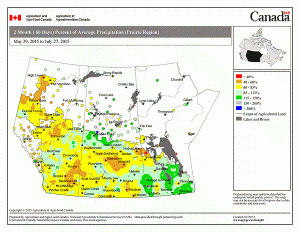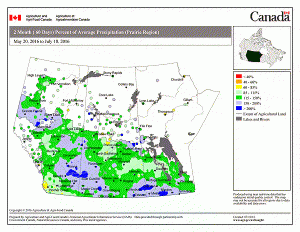Nov 02, 2016 updated Nov 12, 2019
We have a water quality guideline fact sheet, please find the link https://www.ctl.mb.ca/servicesanalysis/water-packages/
At CTL we are committed to continuous improvement & simplify your business with us!
Nov 02, 2016 updated Nov 12, 2019
We have a water quality guideline fact sheet, please find the link https://www.ctl.mb.ca/servicesanalysis/water-packages/
At CTL we are committed to continuous improvement & simplify your business with us!
Aug 31, 2016
Hey are you selling your hay?
So far forage quality has been very poor, We are seeing about a 10 point drop in Relative Feed Value. RFV is a good way to measure hay on how good or bad it is. Here is the calculation: DDM = Digestible Dry Matter = 88.9 – (0.779 x % ADF) DMI = Dry Matter Intake (% of BW) = 120 / ( % NDF ) RFV = (DDM x DMI) / 1.29. A RFV of 100 is equal to Alfalfa that has 41% ADF and 53% NDF. When buying or selling hay, it is very important to get it tested. As a seller, you can be losing money selling a superior product at a lower price. As a buyer you can easily over pay for poor quality. Prices are currently between 2 to 8 cents per pound looking at the MB Agriculture hay listing site (https://web31.gov.mb.ca/HayListClntExtrnl/Search). Only a select few offer a feed analysis of their hay. In a buyers market, having a feed analysis done could mean the difference between selling or sitting on your inventory. For livestock producers, When developing your rations, RFV is not what you want to use, Protein and TDN are the main parameters you should focus on. We offer a full range of forage testing options, please refer to our site at https://www.ctl.mb.ca/servicesanalysis/forage-packages/ or https://www.ctl.mb.ca/servicesanalysis/forage-packages-by-nir-near-infrared-spectroscopy/
Aug 02,2016
Central Testing Laboratory Ltd has been testing protein levels in food and feed since 1924. Protein testing has its challenges, and there are many factors to consider. One factor that has come up is the factor! When testing protein, we actually test the nitrogen level in the sample. If a feed sample has 2% Nitrogen, we multiply that number by 6.25 to give us the crude protein amount of 12.5%. If we are talking wheat going for milling, like most of the wheat grown in Canada, we have to use the milling protein factor of 5.7 to equal the result you get at the local elevator. Our most popular method for protein is by combustion. We can also test by the older Kjeldahl Method. We have also expanded our NIR library to test for Forages and some grains. If you want to dig deeper into the amino acids, we have partner labs that can analyse the profile by HPLC.
July 27, 2016 (updated Nov 13, 2019)
Rain on forage after cutting has shown to cause leaching of nutrients. Namely soluble carbohydrates, proteins and certain minerals. In alfalfa, it can cause leaf loss, which contains the greatest amount of nutrients. Other factors to watch for is heating and mold growth in the bales. With any mold growth can promote mycotoxins that can affect your herds productivity. Testing your forages can help you make sound management decisions on how to move forward with your feeding plans.
Grain quality can be affected by fusarium and vomitoxin. Rain and humidity can cause an environment conducive to fusarium. Any rainfall at harvest or near harvest will also affect falling number, it is best to try to bin this quality separately to avoid quality issues. It is best to test grains before they get sold to determine the best market value.
Contact Central Testing Laboratory today to discuss Grain and Forage testing. info@ctl.mb.ca or 1-877-955-7861


June 30, 2016
Natural Alternative Grazers has some great products to help grazers feed at the same pace as grazing to prevent digestive issues, colic, ulcers, stall vices, cribbing, inhalent allergies and boredom. Please check out their website, they are a Canadian company, they promote hay testing and animal health. www.slowfeeder.com